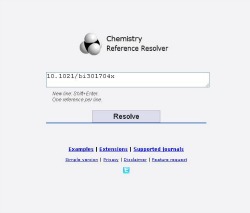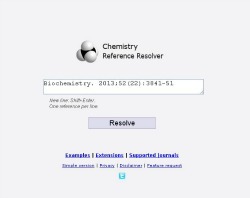Some may call what I’m about to show you magic, while others might offer a rational explanation for how it works. I’ll let you draw your own conclusions. Before reading this post any further, follow these instructions if you are interested in chemistry journal titles:
- Go to Chemistry Reference Resolver
- Paste the following into the text box: Biochemistry. 2013;52(22):3841-51
- Click on Resolve
Viola! You should be brought to the following webpage containing the reference and full text (if available):

As you can see, the Chemistry Reference Resolver–as its name suggests–resolves references provided and points users to the webpage on the web where the citation lives.
Dr. Derek Tan, Director of the Tri-Institutional PhD Program in Chemical Biology, sums up Chemistry Reference Resolver very nicely: “the advantage of [Chemistry Reference Resolver] is that you can copy and paste the plain text reference directly from a paper or grant and have it parsed automatically”. Aside from a standard reference, users can input other information to resolve as well: DOI, US Patent IDs, a journal’s homepage, etc.

Above is a search using DOI

Here is our initial search using the citation
Take a look at all the different ways to search the resource here. Also, there is a list of supported journals provided so users know the resource’s scope.
The MSK Library offers a similar feature to this resource in our Citation Linker. Users can enter as much information about a reference that they have using the form provided. Upon clicking Look Up, the same ‘magic’ takes place behind the scenes (like that of Chemistry Reference Resolver) to point to the appropriate webpage containing the reference, and full text if available. Although this process is not as simple as copy and pasting a DOI, ID number, or reference into a search box, it achieves the same goal and is more comprehensive across disciplines; searching more journals and sources other than chemistry-only.
Give both resources a try and ask us if you have any questions!